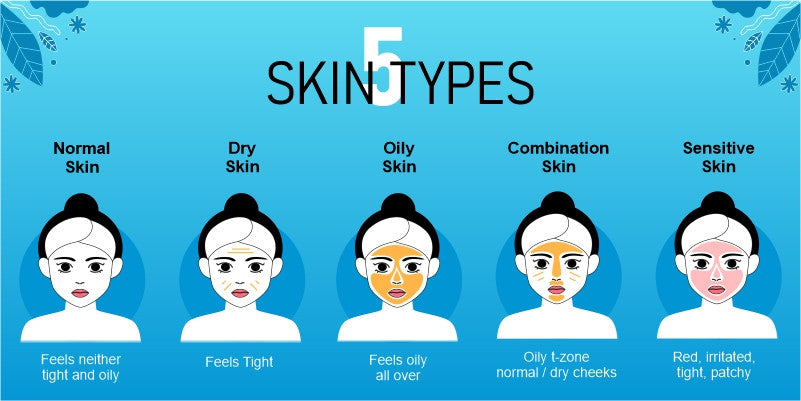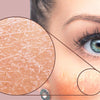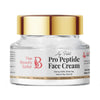Know Your Skin Type

Figure out your skin type once and for all!
Do you know that each skin type reacts differently to every skin care product? Clearly, not all skin is created equal. But besides ethnicity and age; our skin is characterized by its skin type. Commercial products made for the entire population may not really be the best bet for your skin, which is why knowing your unique skin type is extremely essential for a personal perfect skincare. When determining your skin type - it’s important to look at the big picture and take into account all of your skin needs, not just the one or two that bother you most.
Keep reading to find out about your personal skin type and best measures for keeping it healthy -
Basically skin is often classified into 5 main types:
- Normal Skin
Normal skin is balanced—feeling neither dry nor oily. It is not prone to breakouts, flakiness, feeling slick or tight. Your pores will be small and the skin's texture will be smooth; and it is less likely to be prone to sensitivity or blemishes.
- Dry Skin
Dry skin is typically dull and may become rough, flaky or even scaly. Your skin might feel tight or less elastic and may be prone to showing more visible lines. In addition, it may become itchy or irritated. People with highly dry skin need hydrating and moisturizing body lotion, to keep skin awake and breathable.
- Oily skin
Oily skin produces an excess of sebum that causes the skin to appear shiny and feel greasy - especially throughout the T-Zone (forehead, nose and chin). If you have oily skin, you may be more likely to have enlarged pores, develop acne blemishes and be more prone to variety of breakouts. People with oily skin can use coffee face masks to clear the excess oil and impurities; use skin rejuvenating cream to restructure your skin and night gel cream to restore. It will undo all the damage caused during day due to excess oil.
- Combination Skin
Combination skin includes areas that are dry as well as oily—with the T-Zone commonly being oily, and the cheeks being either dry or normal.
Note - If you have combination skin, your face wash plays a really vital role in maintaining the health of your skin since you need products suitable for both dry and oily skin type. Use a tree tree oil face wash, avocado face wash or a mixture of both because avocados and tea tree oil purifies and moisturizes the skin and maintains the overall texture of the skin.
- Sensitive Skin

Sensitive skin is often referred to as a skin type, but you can have oily and sensitive skin, dry and sensitive skin or normal and sensitive skin. Regardless of which type of skin you have, if you have sensitive skin, you will tend experience the following things -
- It may be red,
- Feel like it's burning
- Itching
- Dry
- You are prone to breakouts
- Your skin is highly reactive.
- You sunburn easily.
These symptoms may be related to having skin that is more vulnerable to external irritants and may be triggered by certain ingredients; like dyes or fragrance, as well as environmental factors. If your skin is sensitive, you may be able to determine what triggers your sensitivity and avoid products containing those specific ingredients or alter your environment to reduce your exposure to triggering agents.
Stressed? Worried? Don’t know your skin type?
Stop all that hush hush now and know your skin type without going anywhere.
Follow these two simple tests at home.
Watch and Wait
This at-home test allows you to understand what kind of skin you have by just observing how your skin behaves after cleansing.
- To start, wash your face with a gentle cleanser then gently pat it dry.
- If after 30 minutes your skin appears shiny throughout, you likely have oily skin.
- If it feels tight and is flaky or scaly, you likely have dry skin.
- If the shine is only in your T-Zone, you probably have combination skin.
- If your skin feels hydrated and comfortable, but not oily, you likely have normal skin.
Blotting Sheets

When pressed to the skin, blotting sheets absorb oil—and you can use them to help you understand what type of skin you have.
- After washing your face with a gentle cleanser, patting it dry and allowing it to rest for 30 minutes, press blotting sheets to various areas of your face, then hold the sheets up to the light to see the oil markings.
- If the sheets reveal an abundance of oil in all areas of the face, you have oily skin.
- If they absorb little to no oil, then you probably have dry skin.
- If the sheets show only a small amount of oil from your T-Zone, you have combination skin.
- If you only see minimal oil from every area of your face, you most likely have normal skin.
If you are still not sure what category you fall under , it is time to go to a dermatologist and know your skin type, also we all have different skin , no two people have the same skin but being able to fall under any of the above mentioned categories makes is much easier to make your skin healthy and glowing.
Now introduce your skin care regimen to the right skin care products, because healthy skin always looks beautiful. Say hi to healthy and flawless skin.
-
Posted in
skin care











